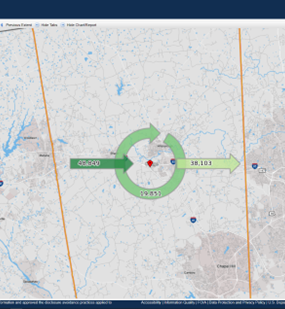Transportation
Keep up with our latest demographic insights

We often receive requests around commuting patterns and answer questions like: How many people live in one location but work in another? How far do people travel to commute to work? What models of transportation do people take to work? Commuting data is particularly useful for thinking about economic development, infrastructure planning, home values, climate change, and other topics. This post will serve as our “How to Guide” on obtaining commuting data from the US…
The number of individuals who reported working from home has increased steadily over the past 35 years. In 1980, fewer than 50,000 North Carolinians reported working at home. Twenty years later, this number had more than doubled, with just over 100,000 individuals working at home in 2000. The number of teleworkers increased sharply in 2006. Since 2012, more than 200,000 North Carolina workers reported working at home each year. In the past, the majority of…
We’ve been digging into the recently released county-to-county commuting flows in some detail over the past few weeks. The 2009-2013 American Community Survey (ACS) provides rich insight into where workers live, where they work, and how they travel between home and work. At multiple points, readers and colleagues expressed surprise about patterns emerging in the data that contradicted their on-the-ground perceptions of transportation use. Upon reflection, it was clear that these contradictions were due, in…
Nearly 440,000 or 10.4% of all North Carolina workers carpool to work according to the 2009-2013 American Community Survey estimates. Nationally, 9.8% of workers carpooled. North Carolina has the 15th highest rate of carpooling among the states. Many counties have a higher rate of carpooling than the state average; many of these counties are smaller counties. Hyde County has the highest rate of carpooling: 22% of its 2,050 workers report commuting to work via carpool.…
Net commuting flows are equal to the number of individuals commuting into a county to work minus the number of residents leaving the county to work elsewhere. A positive net flow or net in-commuting indicates that there are more jobs in the county than there are resident workers. A negative net flow or net out-commuting indicates that there are more workers living in the county than there are jobs. Across the state, 30 counties have…
North Carolina’s 4.2 million workers mainly get to work by car: 81% drive alone and 10% carpool. Working at home (4.4%) and walking (1.8%) are the next most common means of transportation according to the 2009-13 American Community Survey. Only about 1.2% or 50,000 individuals use public transportation to get to work (including taxicabs). North Carolina has the 32nd highest share of workers using public transportation to commute to work. Excluding taxi users, nearly 46,000 North Carolinians or 1.1%…
The other week, we looked at where county residents work. Today we’re using the same 2009-2013 American Community Survey estimates to examine where county workers live. According to the ACS, there were 4.23 million individuals working in North Carolina. The vast majority of these workers – 4.12 million or 97.4%—were also North Carolina residents. Nearly 65,000 of the state’s workers live in South Carolina (1.5% of NC workers) and 17,000 workers commute from Virginia (0.4%…
North Carolina’s 4.2 million workers 16 and older mainly get to work by car: 81% drove alone and 10% carpooled. Working at home (4.4%) and walking (1.8%) were the next most common responses in the 2009-13 American Community Survey. Only about 1.2% or 50,000 individuals reported using public transportation to get to work. How does NC compare to other states? Drive Alone Just over 81% of 3.4 million North Carolina workers drive alone to work…
Each week, more than 4.2 million North Carolina residents embark on a commute to work, according to recent estimates from the U.S. Census Bureau. Most commutes are in-county commutes In most cases, the largest commuting flow is within the county, meaning most people live and work in the same county. Within county commuting occurs among the majority of county residents in 75 of the state’s 100 counties. In another 19 counties, within county commutes are…
Motor vehicle crashes are the leading cause of death for children, teens, and young adults. Each year, there are more than 200,000 motor vehicle-related accidents in North Carolina. The cost of crashes to the state and its residents —including property damage, lost earnings and productivity, medical costs, emergency and safety personnel costs, and more—is in the billions each year. The University of North Carolina Highway Safety Research Center, an interdisciplinary research organization with the goal…
Your support is critical to our mission of measuring, understanding, and predicting population change and its impact. Donate to Carolina Demography today.